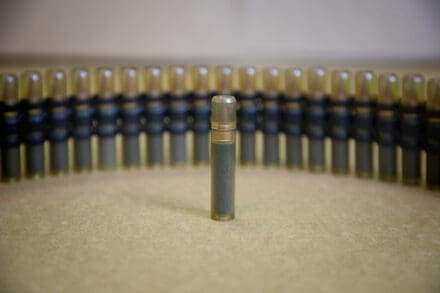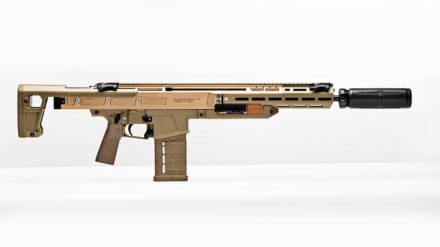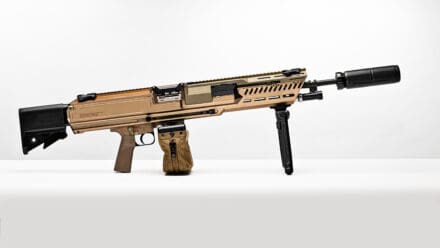Yesterday, Wayne Prender, Textron Systems’ Senior Vice President of Applied Technology and Advanced Programs gave us an update on their Next Generation Squad Weapon candidate system which is currently vying against General Dynamics-OTS and SIG SAUER to outfit the US Army’s close combat forces (and possible the Marines as well) with a new family of weapons in an entirely new caliber, 6.8mm. But Textron isn’t going it alone. They’ve teamed with Heckler & Koch and Winchester, two other small arms powerhouses.
NGSW is an ambitious program in both scope and schedule which will replace the M4 Carbine and M249 Squad Automatic Weapon, both in 5.56mm. The issue with these two weapons is that the US Infantrymen remains overmatched by enemies who employ longer range small arms.
The new 6.8mm cartridge was developed specifically to increase not only range, but also the amount of energy delivered on target. It performs in a similar fashion to the commercial 270 Win Short Mag round and will provide our troops with overmatch of threat small arms. Additionally, the goal is to lighten the whole package, weapons and ammo, at 20% lower than current.
The secret sauce in Textron’s submission is their novel Case Telescoped ammunition. This construction, with the projectile encased within the cartridge and surrounded by propellant, allows it to be shorter than conception SL ammunition.

This ammunition is not only lightweight but also allows for an entirely new operating system with the rimless cartridge being pushed forward throughout the firing cycle.
This operating system is also designed so that the weapon carries the ballistic load of the ammunition during firing rather than the cartridge case. The polymer case also expands slightly during firing.

This is Textron System’s NSGW-Rifle. The program initially called it a Carbine but the performance parameters the Army is seeking really needs a more full-sized weapon. Hence, Rifle.

The belt-fed Automatic Rifle is designed to replace the current Squad Automatic Weapon. The CT ammunition is held together with polymer circumferential links.
Development of the technology for Textron Systems began about 15 years ago, with subsidiary AAI working on the Lightweight Small Arms Technology. With a goal of lowering the weight of both weapon and ammunition, like the current NGSW effort, they initially created a 5.56mm version, then moved on to 7.62mm and finally a 6.5mm variant once research began to indicate that an intermediate cartridge was required.
When the Army decided to field replacements for the M249 and M4, LSAT seemed like a natural starting point. Initial development was referred to as NGSW-T (we’ve shared video of that effort in the past).
This led to the Next Generation Squad Automatic Rifle Production Opportunity Notice with six companies participating. Naturally, Textron was fully engaged and remains so in the current effort.
So far, they’ve concentrated on milestone 1 which is a prototype test, delivering 30 weapons (15 of each type) and 185,000 rounds of ammunition to support testing.
The program office continues to forge ahead on this priority effort, despite the COVID-19 pandemic, with ongoing technical testing at Aberdeen Proving Ground and Soldier Touch Points. Textron’s Prender assures us they are ready to deliver on the current time line and are even poised to scale to the Army’s demands for initial fielding. In fact, they are so confident, they are already working on both blank CT rounds as well as blank firing adapters.
They’ve also embraced the Soldier Touch Points, taking feedback directly from the troops on ergonomics and the manual of arms for this weapon system. They’re integrating this feedback along with data from Aberdeen on their initial reliability and performance testing into their PT 2 build. PT 2 will require the delivery of 30 Rifles, 28 Automatic Rifles and 680,000 rounds of ammunition.
Interestingly, Prender related that Winchester manufactured the CT ammunition in house, using standard ammunition manufacturing machinery. This means that although their program partner Winchester is now operating the Lake City Army Ammunition Plant, it won’t require a huge investment in new technology should they win.
I’m sure Textron Systems has even more in store and can’t wait to see what they show us next time.
To learn more, download Textron’s brochure on their NGSW system, click here.
For some more background on how the Army ended up with NGSW, read this. Admittedly, I was quite skeptical at first, particularly after the Army had just a failed to select a replacement for the M4 just a few years before with the Individual Carbine program and then the start-stop fiasco of the 7.62mm Carbine effort. But, after watching industry rise to the challenge, I quickly went through the stages of grief to acceptance and am now quite optimistic that the Army will field a new capability.


That forward placed ejection port looks like a source of trouble for people gripping the rifle wrong. Too easy to reach with a hand.
It seems like this ejection system would work better in a bullpup
At about 20 sec on the movie you can see that happening.
I agree this would work better as a bullpup
Bullpups are terrible for malfunction clearance. There’s a reason virtually every country that adopted them is moving away from them.
Were just saying given the way this gun operates a bull-pup rifle would work better.
The Textron carbine has really come a long way from its earlier iterations.
Overall I think NGSW is important, in that its pioneering a number of truly next generation technologies (lightweight cases, high pressure cartridges, VLD military projectiles, smart scopes, etc.) Combined, these technologies do represent the future of small arms.
My biggest hesitation is the 6.8 cartridge itself. The 6.8 was originally spec’d for penetrating body armor at range (I’ve heard figures from 300m-600m.) Hence the dramatic ballistics and return to Battle Rifles.
However, while small arms have advanced under NGSW, the current state of Level IV performance may already be mooting any hope of long range armor penetration.
Buffman – a criminally underrated youtube channel – has been testing several Tungsten AP cartridges against Level IV armor. His findings were surprising.
-Level IV stopped 7.62 M993 Tungsten AP 130gr @ 2850fps from 40′ away
-Chinese Level IV ($119) stopped .338 Lapua Tungsten 248gr at 200yds; impact velocity @ 200yds = 2421fps/3228 ft/lbs
Unless a major advance in Tungsten AP technology has been made, it’s hard to see how 6.8 NGSW would be outperforming .338 Lapua in terms of armor penetration range.
At which point, if it can’t penetrate armor at range, perhaps a more moderate cartridge leveraging NGSW technology should be pursued, which would allow for even lighter weapons and ammunition, as well as maintaining 30rd magazines / 150-200rd belts.
For example, a 6mm 85gr EPR VLD 0.229 G7 @ 3,000fps, in the Textron LSAT configuration, would weight less then brass case 5.56, have recoil comparable to 7.62×39, and have a fragmentation and supersonic range beyond 7.62×51.
Energy is only part of the armor penetration formula. Sectional density and bullet construction play a big role too. They have what are/were called ADVAP bullets ( mentioned by Miley in senate hearings over the interim762)and I think that’s probably the second bullet design for this program. Agreed on Buffman, great channel. Karl has a vid up on the Textron guns over on Tactical Rifleman channel , bit of a dog and pony but good to see.
Maybe we should follow the lead of our adversaries and develop better body armor too?
I don’t really follow small arms development that much anymore, but what are Russia and China currently using and developing for the “future”? Anything? Both the Russian and Chinese know that artillery and machine guns are what really kills your enemy.
Who says we aren’t doing that too?
If we fight in the steppes, sure, maybe it helps.
I’m not so sure about the jungle.
IMO there are 2 potential theaters for near-peer.
This might help in the steppes.
I’m not so sure about the beach and jungle.
The auto rifle looks great overall, interesting feed cover, looks interesting and effective overall, there has been alot of development on it from the LSAT program.
The rifle on the other hand, based on other footage of this, it seems to have quite a lot of recoil, also that ejection port seems to interfere with both hands and grenade launchers.
Interested to see where it goes with that high pressure ammo, but I have a bad feeling about the rifle’s shortcomings
Sigs LMG I think is better it looks more tactical and compact compared to textrons LMG
Yeah, personally i’m a proponent of GD’s bid, but I didn’t want to get into the whirlpool of comparing the different NGSW bids, i’ll leave that to the army
Is it because of GD’s ammo?